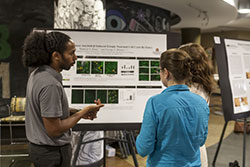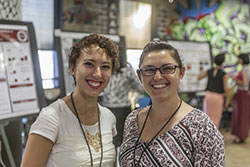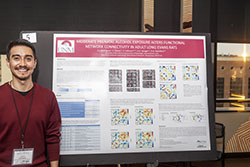Graduate students across the United States and Puerto Rico recently gathered in Birmingham for the second annual, NIH-sponsored NEURAL Conference at the University of Alabama at Birmingham.
 NEURAL stands for National Enhancement of UnderRepresented Academic Leaders.
NEURAL stands for National Enhancement of UnderRepresented Academic Leaders.- Presented their own neuroscience research through oral presentations and poster sessions;
- Heard seminars by leading neuroscience researchers from the University of Minnesota, New York University Medical Center and Columbia University;
- Networked with UAB faculty, outside speakers, the 25 UAB Roadmap scholars and one another; and
- Grew their professional development through workshops on personal finance, goal setting and motivation, how to develop an e-portfolio, and the do’s and don’ts of a successful paper submission.
“I can’t say enough about how uplifting it was,” he continued, “to enjoy topnotch science and professional development in a context rich with the mutual respect and safety provided by a commitment to best-practice science … science that begins with, and does not exist without, a commitment and consistent practice to real diversity.”
| “When I think back on it, my disability made me a better scientist and gave me interest and motivation to pursue research in neglected area.” Gordon Legge, Ph.D. |
The students who came to the conference from other schools were joined by 55 UAB graduate trainees — including UAB’s Roadmap Scholars — and more than 90 other UAB trainees, students, faculty and staff.
Engage and retain
As Lori McMahon, Ph.D., the Jarman F. Lowder Professor of Neuroscience, dean of the UAB Graduate School and director of the UAB Comprehensive Neuroscience Center, has said, the Neuroscience Roadmap Scholars Program and the NEURAL Conference strive “to help those students who view themselves as having a challenge or having a disability or not being ‘good enough.’ We try to give them the tools they need, empower them and make them realize their own abilities, so that they will stay in neuroscience research.”
One path to this empowerment is securing keynote speakers who are esteemed neuroscientists who have overcome daunting challenges.
Last year, famed neuroscientist Roger Nicoll, M.D., University of California, San Francisco, told how he overcame crippling dyslexia that hobbled him to a 2.13 high school GPA and a 58th percentile SAT.
 20/1,000 vision
20/1,000 visionThis year, Gordon Legge, Ph.D., professor of psychology at the University of Minnesota, told the NEURAL students how a life-threatening bout of Stevens-Johnson syndrome at age 6 left him with extraordinarily poor visual acuity. While 20/20 vision is the conventional standard of normal eyesight, to have less than 20/60 is considered “low vision” and a 20/200 vision is legal blindness. But the human eye, Legge explained, can still maintain acuity to 20/2,000 vision.
Somewhere between 3.5 million and 5 million people in the United States are visually impaired, said Legge, reading his talk from a pad of Braille notes. “Most are low-vision, not blind … My visual acuity is between 20/1,000 and 20/2,000.”
He explained that he went into low-vision neuroscience research to study ways to help low-vision people find adaptive ways to read.
Legge uses three senses to keep up with his correspondence and the literature in his field:
- His eyes: He uses a closed-circuit television magnifier to enlarge letters to 1.3 inches tall.
- His ears: He listens to computer-generated speech from electronic documents at 250 words per minute.
- His fingertips: He reads the bumpy code that was invented by Louis Braille in the early 19th century.
“I use any — and all — resources to get the job done,” Legge said. “When I think back on it, my disability made me a better scientist and gave me interest and motivation to pursue research in neglected areas.”
| Universities represented at the 2016 NEURAL Conference CUNY-Graduate Center Delaware State University Florida Atlantic University Florida State University Michigan State University Miles College New Mexico State University Pontificial Catholic University of Puerto Rico, Arecibo Campus Southeast Missouri State University Tuskegee University University at Buffalo University of Alabama University of Colorado Anschutz Medical Campus University of Kentucky University of New Mexico University of North Carolina University of Puerto Rico at Cayey University of Puerto Rico, Medical Sciences Campus University of Puerto Rico, School of Medicine University of Virginia The NEURAL acronym stands for National Enhancement of UnderRepresented Academic Leaders. |
A workshop led by Farah Lubin, Ph.D. — Stereotype Threats and Implicit Bias — proved to be powerful.
Stereotype threat, explained Lubin, who is co-director of the Roadmap program and an associate professor of the UAB Department of Neurobiology, is a situation in which people feel themselves to be at risk of conforming to stereotypes about their social group.
For example, you sit down for a crucial college entrance exam that you have spent years preparing for, and you find the first question asks you to fill in the appropriate bubbles for your race and gender. Researchers have found that this can remind students of negative stereotypes that can make students perform worse on the test, especially if the negative stereotype is one that makes them feel academically inferior.
Implicit bias
Implicit bias, Lubin says, is a subtle and pervasive bias against members of a group merely by virtue of their membership in that group. Unlike overt bias, people with implicit bias may not be aware of the tacit attitudes they have about the target group. They may unintentionally act in ways that have negative impact on the targets of their implicit bias.
An example might be an instructor who allows men or whites to talk without raising their hands, but not women or people from underrepresented groups.
Shared examples
To help prompt discussion, each eight-person table of students discussed 11 questions about stereotypes and implicit bias, moderated by UAB faculty or staff. Questions included:
- Is everyone equally threatened and disrupted by a stereotype?
- Are you a stereotype?
- Do gender stereotypes annoy you? Should they annoy you?
One of the most stimulating asked: “Have you experienced or been subjected to implicit bias?” This evoked shared personal examples and intense dialogue among students of each table group.
 Toolkit
ToolkitThe final workshop was “The Neuroscientist’s Toolkit for Research and Career: Empowering Yourself to Follow Your Passion,” given by Michelle Jones-London, Ph.D., director of Diversity Training and Workforce Development at the National Institute of Neurological Disorders and Strokes.
She noted that brain disorders — both developmental and degenerative — will be the most costly and disabling chronic diseases of this century, much as infectious diseases were in the 20th century.
She explained why diversity is important to NINDS and how the institute supports underrepresented students. She described her own career path through a Ph.D. at Penn State and postdoctoral training at Penn, and she stressed how much networking matters.
She also shared what she wished she had known back in graduate school:
- If the mentors and colleagues whom she trusted had confidence in her abilities, then she should have had confidence in her abilities too
- Grad school is hard for everyone
- Not everyone will believe in your talents or think you belong in science
- Know how to ask for help, whether it’s experiments, lab dynamics or personal issues
- Take part in activities outside of research — this will actually make the research more productive
| Shark Tank One new feature of the second annual NEURAL Conference was four Shark Tank contests to win travel awards to future conferences. Modeled after the reality television show where would-be entrepreneurs pitch their business ideas to a panel of investors, the UAB Shark Tank gave students three minutes each to describe their research to the conference attendees and a panel of judges. The winners were: Cagney Coomer, University of Kentucky Nathaniel Harnett, UAB Rosa Jaiman, Michigan State University Emmanuel “Mani” García-Lesy, City University of New York Graduate Center |
Since returning home, students have sent thanks in notes to Jamie White and Tiffany Alexander, the administrators who kept the conference going.
“NEURAL,” wrote García-Lesy, “is a model of what research and academic programs must embrace to ensure they remain sustainable, competitive and worthy of the funding, resources and talent enriching them. I am really looking forward to next year."
“This was my second time attending the NEURAL Conference,” wrote Shahzad Khan, University of Virginia. “I generally have the impression that the conference is carefully planned for the unique needs of underrepresented scientists-in-training. I find the personal and professional development workshops to be extremely valuable.”
“Hearing the passion with which the conference participants present their research,” Khan continued, “is both inspiring and motivational.”
“One of my favorite conferences”
“Thanks … for organizing this event,” wrote Carlos Rodriguez, University of New Mexico. “It was such a positive experience to visit Birmingham, the UAB campus, and to get a chance to grow and develop as a scientist. Right after I left Birmingham, I went to another conference and had the chance to speak with a couple of NIH program officers. I told them about my positive experience and let them know that it should be on their radar.”
Jennifer K. Ocasio, University of North Carolina, said, “I can’t even begin to express how much I enjoyed the conference and how honored I am to have been given the chance to attend and present my research. I was super impressed with the whole event, and I wanted to let you know that it’s definitely been one of my favorite conferences. I’ve made some great new friends, made some awesome connections, and learned a lot of valuable information and skills.”